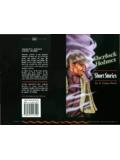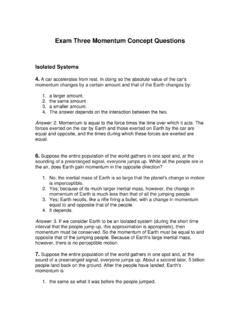Transcription of A very brief measure of the Big-Five personality domains
1 A very brief measure of the Big-Fivepersonality domainsqSamuel D. Gosling,*Peter J. Rentfrow, and William B. Swann of Psychology, University of Texas, Seay Psychology Bldg. Rm. , Austin, TX 78712, USAA bstractWhen time is limited, researchers may be faced with the choice of using an extremely briefmeasure of the Big-Five personality dimensions or using no measure at all. To meet the needfor a very brief measure , 5 and 10-item inventories were developed and evaluated. Althoughsomewhat inferior to standard multi-item instruments, the instruments reached adequate levelsin terms of: (a) convergence with widely used Big-Five measures in self, observer, and peer re-ports, (b) test retest reliability, (c) patterns of predicted external correlates, and (d) conver-gence between self and observer ratings.
2 On the basis of these tests, a 10-item measure ofthe Big-Five dimensions is offered for situations where very short measures are needed, person-ality is not the primary topic of interest, or researchers can tolerate the somewhat diminishedpsychometric properties associated with very brief measures. 2003 Elsevier Science (USA). All rights IntroductionOne obvious way to learn about an individual s standing on a personality trait issimply to enquire directly about that trait. For constructs, such as Extraversion, thatare widely understood, it is more straightforward simply to ask a person how extra-verted he is than to ask him whether he enjoys the company of others, attends partiesfrequently, is talkative, outgoing, gregarious, and enthusiastic. That is, why not ask aqPreparation of this article was supported by a research grant from the University of Texas College ofLiberal Arts and National Institutes of Mental Health Grant RO3 MH64527-01A1.
3 We thank VeronicaBenet-Martinez, Matthias R. Mehl, and Richard W. Robins for their helpful comments on earlier drafts ofthis paper.*Corresponding author. Fax: Gosling).0092-6566/$ - see front matter 2003 Elsevier Science (USA). All rights (03)00046-1 Journal of Research in personality 37 (2003) 504 OFRESEARCH INPERSONALITY person one direct question about a trait rather than many questions about the multi-ple, narrow components that comprise the trait?The widely accepted answer is that, all things being equal, long instruments tendto have better psychometric properties than short instruments. However, the costsassociated with short instruments are not always as great as is feared (Burisch,1984a, 1984b, 1997). More important, there are some instances when short instru-ments permit research that would not be possible using long Why are short instruments needed?
4 In an ideal world, personality researchers would have sufficient time and resourcesto exploit the superior content validity and reliability of well-established multi-iteminstruments. Unfortunately, circumstances are often not ideal and researchers maybe faced with a stark choice of using an extremely brief instrument or using no in-strument at all. For example, one Internet-based study used a single-item measureto obtain ratings of self-esteem from participants who would be unlikely to dwellat the website long enough to complete a multi-item questionnaire (Robins, Trzes-niewski, Tracy, Gosling, & Potter, 2002). Studies that require participants to ratethemselves and multiple others on several occasions may also profit from the useof short scales. In one longitudinal study of interpersonal perceptions, participantswere required to rate several other group members on several traits on several occa-sions (Paulhus & Bruce, 1992); multi-item scales would have burdened participantsexcessively so single-item measures were used.
5 Other useful applications for short in-struments include large-scale surveys, pre-screening packets, longitudinal studies,and experience-sampling studies (Robins, Hendin, & Trzesniewski, 2001a).Although single-item scales are usually psychometrically inferior to multiple-itemscales, single-item measures do have some advantages. In developing a single-itemmeasure of self-esteem, Robins et al. (2001a) noted that single-item measures ..eliminate item redundancy and therefore reduce the fatigue, frustration, andboredom associated with answering highly similar questions repeatedly (p. 152; alsosee Saucier, 1994). Indeed, Burisch (1984b, 1997) showed that short and simple de-pression scales can be just as valid as long and sophisticated scales. For example, selfand peer reports converged just as strongly for a truncated 9-item depression scale(r :54) as for the full 50-item scale (r :51).
6 Burisch s findings suggest that thesupposed psychometric superiority of longer scales does not always translate intopractice. If the psychometric costs of using short scales are not as steep as mightbe expected, their relative efficiency make them a very attractive research tool. Thewidespread use of single-item measures is a testimony to their appeal. Single-itemmeasures have been used to assess such constructs as life-satisfaction (Campbell,Converse, & Rodgers, 1976), subjective well-being (Diener, 1984; Sandvik, Diener,& Seidlitz, 1993), affect (Russell, Weiss, & Mendelsohn, 1989), cultural/ethnic iden-tity (Benet-Mart nez, Leu, Lee, & Morris, 2002), relationship intimacy (Aron, Aron,& Danny, 1992), attachment style (Hazan & Shaver, 1987), intelligence (Paulhus,Lysy, & Yik, 1998), and self-esteem (Robins, Tracy, Trzesniewski, Potter, & Gosling,2001b).
7 Gosling et al. / Journal of Research in personality 37 (2003) 504 Previous Big-Five instrumentsIn this report, we evaluate new 5 and 10-item measures of the Big-Five personalitydimensions. The Big-Five framework enjoys considerable support and has becomethe most widely used and extensively researched model of personality (for reviews,see John & Srivastava, 1999, and McCrae & Costa, 1999), although it has not beenaccepted universally (Block, 1995).The Big-Five framework is a hierarchical model of personality traits with fivebroad factors, which represent personality at the broadest level of abstraction. Eachbipolar factor ( , Extraversion vs. Introversion) summarizes several more specificfacets ( , Sociability), which, in turn, subsume a large number of even more spe-cific traits ( , talkative, outgoing).
8 The Big-Five framework suggests that most in-dividual differences in human personality can be classified into five broad,empirically derived rating instruments have been developed to measure the Big-Five dimen-sions. The most comprehensive instrument is Costa and McCrae s (1992) 240-itemNEO personality Inventory, Revised (NEO-PI-R), which permits measurement ofthe Big-Five domains and six specific facets within each dimension. Taking about45 min to complete, the NEO-PI-R is too lengthy for many research purposes andso a number of shorter instruments are commonly used. Three well-establishedand widely used instruments are the 44-item Big-Five Inventory (BFI; see Benet-Mart nez & John, 1998; John & Srivastava, 1999), the 60-item NEO Five-Factor In-ventory (NEO-FFI; Costa & McCrae, 1992), and Goldberg s instrument comprisedof 100 trait descriptive adjectives (TDA; Goldberg, 1992).
9 John and Srivastava(1999) have estimated that the BFI, NEO-FFI, and TDA take approximately 5,15, and 15 min to complete, respectively. Recognizing the need for an even briefermeasure of the Big Five, Saucier (1994) developed a 40-item instrument derived fromGoldberg s (1992) 100-item Overview of present researchIn two studies, we evaluate new 5 and 10-item measures of the Big Five in terms ofconvergence with an established Big-Five instrument (the BFI), test retest reliability,and patterns of predicted external correlates. In Study 1, two samples were assessedusing both the new five-item instrument and the BFI. Convergent and discriminantvalidity was examined in a sample of 1704 undergraduate students who were assessedusing both instruments. To compare the pattern of external correlates of the 5-iteminstrument with the pattern of external correlates of the BFI, we also administered abattery of other instruments.
10 To assess the test retest reliability of the 5-item instru-ment and of the BFI, a subset of 118 participants were assessed again two weeksafter the initial assessment. To evaluate the performance of the measure whenused in observer-report format, a second subset of 60 participants were rated byobservers after a brief getting acquainted exercise. To examine the measure whenused in peer-report format, we also collected peer reports from a new sample of83 Gosling et al. / Journal of Research in personality 37 (2003) 504 528In Study 2, one sample was assessed using both the 10-item instrument and theBFI. Convergent and discriminant validity was examined in a sample of 1813 under-graduate students who were assessed using both instruments. To compare the pat-tern of external correlates of the 10-item instrument with those of the BFI, abattery of other instruments was also administered.






